 |
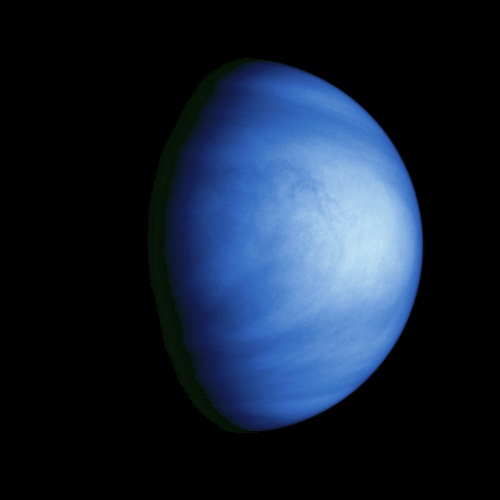 |
GST 2420: Atoms & Stars
A Historical Introduction to Astronomy, Physics, and the Process of Scientific Discovery.
|
Time & Place: Thursday, 6:00-9:40 p.m., Cohn Bldg. |
|
Note: This syllabus and other class materials can be accessed at: www.is.wayne.edu/MNISSANI/A&S/a&s.htm |
|
I wish I could tell you about inspirational teachers in science from my elementary or junior high or high school days. But, as I think back on it, there were none. There was rote memorization . . . but there was no soaring sense of wonder, no hint of evolutionary perspective, and nothing about mistaken ideas that everybody once believed. . . . College was the fulfillment of my dream: I found teachers who not only understood science, but who were actually able to explain it--Carl Sagan |
Contact information for Moti Nissani:
 |
 |
Work Address (but please use e-mail or my home address below—I’ll get it faster this way): Moti Nissani, Interdisciplinary Studies Program, Rm. 2134, 2nd floor, 5700 Cass, Wayne State University, Detroit, MI 48202
Home Address: 28645 Briar Hill, Farmington Hills, MI 48336
E-Mail: moti.nissani@wayne.edu
Tel.: 248.427.1957 (h) (12-10 p.m. every day)
Internet Homepage: www.is.wayne.edu/mnissani/
Class Internet Address: http://www.is.wayne.edu/MNISSANI/A&S/a&s.htm
Office hours: Call or e-mail to arrange an appointment
General Education Requirements: Wayne State is committed to imparting quality well-rounded education to all its undergraduates. As part of this goal, the university created a set of requirements (e.g., English proficiency, a minimum of one course in the life sciences), that each undergraduate must meet. GIS 2420 (Atoms & Stars) satisfies the Physical Sciences (PS) requirement.
Text: Atoms & Stars, $17. This reader will be sold in class. You need to buy it this week to do next week's assignment. A Laboratory manual will be sold separately on the fourth week of class.
| Grading: Exercises and papers:
25%; Midterms and Final, 50%; attendance, 25%;
Optional Show & Tell: You can earn an additional 5-10% in this class, and get much more out of it, by making a significant contribution to it. This will take priority over the regular schedule. This can involve bringing in your telescope and sharing it with the class, preparing a presentation on UFOs, acting out the skit of Week 3, sharing a favorite segment of a film, sharing a song, or prevailing upon a friend to come and talk to us about her hobby or job. Guest speaker will be particularly welcome. Any views, especially views different from the ones aired in class, are welcome. For example, it will be interesting to know what your pastor has to say about the biblical passage of A&S, Week 7 (see below). Or better still, invite her to debate a scientist (your humble instructor) and enjoy the fireworks! There are only two qualifications:
|
 |
Overdue Assignments: Penalties for late submissions or late test-taking: one week or less—one grade point (e.g., a C paper will be recorded as a D paper).
After more than one week—and in fairness to your fellow students who did this assignment before it has been discussed in class—all late submissions will be returned unread. In that case, you can either take an E for this assignment or make it up fully by taking a closed book test on the material you missed. All make-up tests will be given during the final session (examination week). Please notify the instructor in writing of your intention to take such a test on or before the week preceding the last session. The grade you earned in the make-up test will constitute the grade for that assignment.
|
Consumer Information: Here is the grade distribution for my last class (by the way: can you see a regularity, a pattern, here?) |
||
| Last 3 Digits of Student ID | Attendance (maximum possible: 52 hrs) | Final Grade |
| 420 | 52 | A |
| 969 | 52 | A |
| (53)038 | 52 | A- |
| 637 | 49 | B |
| 772 | 48 | B |
| 203 | 47 | A- |
| 688 | 46 | B |
| 748 | 44 | B |
| (59)038 | 41 | B |
| 434 | 41 | C |
| (95)343 | 40 | C |
| 454 | 40 | C+ |
| 161 | 38 | C- |
| 451 | 36 | I |
| 643 | 34 | C+ |
| 658 | 28 | C- |
| 652 | 22 | X |
| (64)343 | 17 | X |
| 955 | 8 | X |
Rewrites: All papers can be revised and rewritten for a higher grade. All rewrites can be submitted at any time throughout the term. The original draft must-I repeat, must-be re-submitted with the new revised draft. You can thus raise your grade for that particular paper by as much as 1.5 grade points. For instance, if you received a D and then revised the paper up to a A level, the recorded grade would be C+. Again, only the highest of the two grades will be counted.
Make-ups: All tests and quizzes can be retaken during the last session. A particular grade can thus be raised by as much as 1.5 points. To do so, you will need to sign up on the week before our last session. The last grade would be the final grade.
A note about computers: If you don’t have a computer already, seriously think about getting a laptop (or a desktop). A used computer in good condition (with a 6-month total warranty) will pay for itself in a few months—in time saved, in higher grades, in spelling checks, in library trips, newspaper subscriptions, consumer information . . . Likewise, We can’t overemphasize the usefulness of e-mail. We check my e-mail at least every other day, so you can speed up your progress in this class immensely by having an e-mail account. Without e-mails weeks pass by between writing an assignment and getting my input; with e-mail, the entire process can be condensed into days.
General Description: I'm not going to describe this course here, since it has already been described in the Prefaces to the A&S Reader. I'll just say this. Most likely, if you apply yourself, if your English (not science, English!) is good enough, if you possess sufficiently good study skills, if you can attend class regularly, if you can put some 6-10 hours a week of homework into this 4-credit class, and if you are curious about things, you will learn quite a bit this term. T
The main goals of this class is to foster your love for science, to help you become a bit more skeptical and open-minded, to impart a deep understanding of some key concepts in the philosophy of science, in astronomy, and physics, and to show you that scientific developments daily shape and alter your ways of thinking. To achieve these goals, we shall emphasize depth and flexibility, not breadth and a commitment to cover and do everything; we thus may drastically change the schedule below as we go along, skipping some topics entirely and adding others. To put this differently, no matter how hard we try, we can only cover fragments of this immense subject. But the few that we do cover, we'll cover well and in depth. Still, if you are the kind of person who must know, now, what we'll cover on Week 10, this class is not for you.
Laboratory Component: A good number of the laboratory exercises are already included in the syllabus below and in your A&S Coursepack. The rest are described in the Laboratory Manual which will be sold separately ($3) in the fourth week of class. At that time, you will also receive a syllabus supplement which will give times, dates, assignments, and additional procedures of these exercises.

GST 2420: Tentative WEEKLY SCHEDULE
WEEK 1 (Thursday, January 10, 2002, 6:00-9:40 p.m.)
Introduction; technicalities; on reading scientific literature; What is Science?; physics and astronomy literacy game; note-taking practice; a preliminary look at the sky; moon/sun angular separation;
Class reading and discussion: In Praise of Literacy (pp. vii-viii)
Designing a Scientific Experiment: Comparative density of mercury and water:
 |
 |
Class Activity: Divide into groups and carry out Exercise I: Collapsing Can (A&S Reader, pp. 1-4; assignments 1-12).
Preview of next week, with special emphasis on Phases of the Moon Exercise, assignments, and class readings.
| WEEK
2 (January 17, 2002)
Assignments due: Take-home Exercise I (A&S Reader, pp. 1-4; assignments 1-12), and answers to water/mercury experiment above. Please note: no make-ups of any kind will be accepted for this assignment. If you are late, the only way you can make up for this is take a make-up test on this material on Week 15. Note: If you submit the assignment on time, and are unhappy with the grade, you can rewrite it. In that case, only the second grade counts. If you wish to speed up the process, and if you want to read (as opposed to guess) my comments, you can send me an e-mail any time before the due date. In that case, you'll receive my reply and comments within 48 hours. If you don't, that means your message got lost in cyberspace. In that case, send it to me again or call. All your e-mail attachments should bear your last name at the beginning, e.g., Smith Can Exercise. |
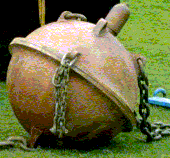
Magdeburg Sphere |
Read: A&S pp. 1-16.
Topics: Review of Collapsing Can Exercise; What is science?; The development of the concept of atmospheric pressure.
Demonstrations: Magdeburg spheres; suction pump--a syringe; the principle of the pipette.
Case Study in Science: Gallup’s Self-recognition: A Thought Experiment
Class Discussion and Background: WE ARE ALL SCIENTISTS (pp. 5-8; T. H. Huxley):
|
Small Group Discussion Questions
|
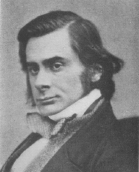
Biographical Note: : Thomas Henry Huxley (1825-95) made his reputation as a marine biologist while serving as a ship's surgeon off the coast of Northern Australia. Later he turned to the study of fossils, especially those of fishes and reptiles. He became a leading supporter of Darwin's and Wallace's evolutionary theory. Following a detailed study of anthropology, he published Man's Place in Nature (1863), and coined the word agnostic to describe his views on religion. Huxley was a supporter of education for the less privileged and argued for the inclusion of science in the school curriculum. The brothers Julian Huxley (Nobel Prize winner in biology) and Aldous Huxley (the well-known novelist and essayist) are his grandchildren. This charming essay was written a long long time ago (1863), yet it still beautifully captures the nature of science and its similarities to ordinary experiences.
|
Class Activity: Constructing a water barometer (class handout)
Preview of next week. Two volunteer actors are needed; moon exercise
Reminder: Friday, January 18, 2002 is the last day to drop or add a class with no financial penalty
|
WEEK 3 (January 24, 2002) Read: pp. 17-26
Begin this week: Month-long Phases of the Moon home activity (pp. 135-137). Topics: The development of the concept of atmospheric pressure. Class Activity: Predictions of Torricelli’s Sea of Air Hypothesis (pp. 27-8). |
 16 Horses pulling a Magdeburg
spheres; notice that the sphere is off the ground. 16 Horses pulling a Magdeburg
spheres; notice that the sphere is off the ground. |
Science Play: (pp. 32-4; Two volunteers are needed)
Case Study in Science: Obedience (a thought experiment followed by film).
| WEEK
4 (January 31, 2002)
Read: pp. 59-65 Continue at home: Phases of the Moon Topics: Speed of Light and the Nature of Science Midterm: Open book, multiple choice on key concepts covered on weeks 1-3 |
Designing Scientific Experiments: Double-Up! (pp. 35-7) Besides having fun tonight, we're trying to learn something from this experience. So, here are some guidelines about how to maximize your winnings:
|
| WEEK
5 (February 7, 2002)
Assignment due: Answers to three of four questions on p. 31 (Conceptual Activity: Atmospheric Pressure and the Nature of Science, pp. 29-31) Read: pp. 66-79 Continue at home: Phases of the Moon Topic: Atomic nature of matter Class Activity: Electrolysis Designing Scientific Experiments: Is Drug X (class choice) effective? Preview and teams for next week. |
 |
WEEK 6 (February 14, 2002)
Read: pp.
Continue at home: Phases of the Moon (pp. 135-7)
Assignment: Nature of Science and Critical Thinking: Class divides into teams. Each team covers one of the readings and presents it to the class in as fun and interesting way as possible. You may teach us the article in any way you want--try to be as creative as you can. There is no need to consult additional sources. Your presentation will be followed by a discussion of the nature of science. The readings are:
Designing Scientific Experiments: Is Astrology (or Card Reading) a Science?
Assignment due Today: Atmospheric pressure paper:
Instructions for Atmospheric Pressure Fill-In-the-Blanks Paper
Due date: Week 6
Minimum: 3 typewritten, double-spaced, pages.
Topic: Based on class discussions, your reflections, and assigned readings (A&S pp. 9-26), apply 5 steps (1, 4, 5, 6, 7) of the 7 steps described in the section "The Detective as Scientist" (A&S, pp. 10-14) to the historical development of the concept of atmospheric pressure. Each paragraph should begin with my words and end up with your words. You can save yourself typing by downloading these instructions from the internet: http://www.is.wayne.edu/mnissani/a&s/a&s.htm
In writing this paper, please adhere to the following outline:
I. Introduction: How does a detective solve a crime? [In their effort to solve a crime, detectives typically proceed through five steps. At this point I would like to explain the nature of these five steps and to illustrate them . . .]
II. The scientist as a detective. The process of scientific discovery resembles the process of detective work. In both cases you solve a puzzle. In this paper I shall use the historical development of the concept of atmospheric pressure in order to show that scientists operate very much like detectives.
III. Before doing this, I shall briefly explain how these steps successfully apply to the historical development of the kinetic theory. In this case the problem was . . . It was a problem because . . . The hypothesis was . . . This hypothesis explained the problem because . . . This hypothesis led first Count Rumford to the following deduction and test . . . Later, it led Davy to another deduction and test. . . . In this case, the application involved . . . This practical application would have not been possible without Rumford's hypothesis because . . .
IV. What was Torricelli's problem? Why was he dissatisfied with his predecessors' belief that "nature abhors vacuum?"
IV. What was Torricelli's hypothesis? How did this hypothesis explain his problem? How did it explain wine not flowing out of a one-holed barrel? Why was his new hypothesis superior to the one that nature hates vacuum?
V. Deducing and testing further consequences. In each of the four cases below, you should cover the following topics. How does Torricelli's sea of air hypothesis suggest this test? (In each case, the reasoning is this: if the hypothesis is correct, then I would expect something to happen). How was the actual test conducted? In what way did each test lend support to the hypothesis?
a. Torricelli's deduction and test. If sea of air exists, then mercury should rise to a height of . . . feet. Why? What happened when this deduction put to the test? How does this test support the sea of air hypothesis?
b. Apply the same process to Pascal's deduction / Perier's test
c. And to von Guericke's deduction and test
d. And to Boyle's deduction and test
VI. Application. Advances in scientific knowledge often lead to practical applications. The insights we gain from pure science help us develop useful tools. Once humanity grasped the idea of atmospheric pressure, it was possible to apply this idea to the development of two instruments which could not be invented without it. The two instruments are . . . They could not be developed without an understanding of atmospheric pressure because . . .
| WEEK
7 (February 21, 2002)
Read: pp. 83-102 Continue at home: Phases of the Moon Assignments due: Choose one option:
Possible Topics: The Splendor of Greece, The Greek Mind, Greek Science and Math; Euclid, Strato, Aristarchus of Samos; an appraisal: Greek contribution to modern science; preview of Archimedes' Exploits exercise (pp. 103-20). Film: Planetary Motion (10 min.) Midterm: Open book on key concepts covered on weeks 4-6. |
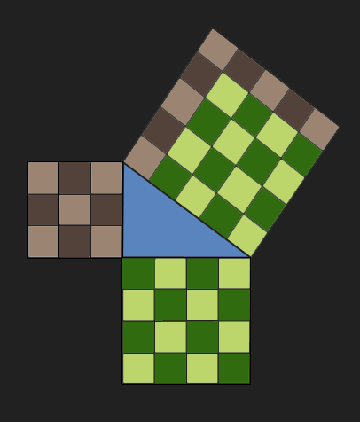
The Pythagorean Formula: C2 = A2 + B2 |
Class Activity: A key ingredient in science is open-mindedness. It's a sad scientist indeed who is unwilling to listen and change. To bring the point home, to show how hard this is, let's look at something a bit less arcane than black holes and mathematical proofs. Read the passage below (with the help of a dictionary, if necessary), then close the book and summarize the passage in plain English. This written summary will be followed by class discussion, to make sure that we agree on what the passage says. We shall then be ready to address the key question: Did this passage change in any way your view of Jesus? Moral: If you didn't change, you know how hard change is, and why science (but not religion) is always moving forward!
Note: The exercise does not assume that you are a Christian; we chose this passage simply because most people think they know Jesus. The same kind of exercise could be carried out with most other religious or historical figures.
St. Matthew, Chapter 15, 22-29:
MAT 15:22 And, behold, a woman of Canaan came out of the same coasts,
and cried unto
him, saying, Have mercy on me, O Lord, thou son of David; my daughter
is grievously vexed
with a devil.
MAT 15:23 But he answered her not a word. And his disciples came and
besought him, saying,
Send her away; for she crieth after us.
MAT 15:24 But he answered and said, I am not sent but unto the lost
sheep of the house of
Israel.
MAT 15:25 Then came she and worshipped him, saying, Lord, help me.
MAT 15:26 But he answered and said, It is not meet to take the
children's bread, and to
cast it to dogs.
MAT 15:27 And she said, Truth, Lord: yet the dogs eat of the crumbs
which fall from their
masters' table.
MAT 15:28 Then Jesus answered and said unto her, O woman, great is thy
faith: be it unto
thee even as thou wilt. And her daughter was made whole from that very
hour.
MAT 15:29 And Jesus departed from thence, and came nigh unto the sea
of Galilee; and went
up into a mountain, and sat down there.
| WEEK
8 (February 28, 2002)
Read: pp. 121-8 Continue at home: Phases of the Moon Class Activity: The Nature of Mathematics:
Topics: Mathematics; The universe; astronomical numbers Class Activity: The size of the solar system Film: |

An image of globular cluster M13, containing perhaps more than 100,000 stars. It is about 25,000 light years from us. |
WEEK 9 (March 7, 2002):
Read: 138-61
Topics: Black Holes, Our Moon, The Telescope, Galileo and Dogma
Conceptual Activity: Quo Vadis, Jupiter?
Preview of Week 10: 2 volunteer lecturers needed
WEEK X (March 14, 2002): NO CLASS (Spring Recess)
| WEEK
10 (March 21, 2002)
Read: pp. 163-85 Topics: The Planet Mars; Kepler's 3 Laws; Some implications of natural laws to human beings: The Cold Equations Film: Kepler's 3 laws (30 min.) Submit: Lab report on Phases of the Moon (pp. 27-30) Two student lecturers:
Class Activity (weather and skies permitting): The telescope. Questions: 1. How can you tell if the telescope presents reality? 2. How does Earth's moon look like? 3. Appearance of Jupiter and its moons. Midterm: Open book on key concepts covered on weeks 6-9 Divide into teams and select a presentation topic for next week. |

The planet Mars |
| WEEK
11 (March 28, 2002)
Read and prepare a group presentation on: One article you chose last week, pp. 203-13 Assignment due: Divide into teams, with each team choosing one of the greenhouse articles in the coursepack and preparing a class presentation of that article. . Topics: The greenhouse effect Class Activity: Can CO2 Trap Heat? Film? Midterm: On material covered on weeks 7-9 |

Source: J.T. Houghton, et. al., Climate Change: The IPCC Scientific Assessment, 1990. |
| WEEK
12 (April 4, 2002)
Read: pp. 265-84 Topics: The telescope, Galileo, and dogma Class Activity: Quo Vadis, Jupiter? (class handout) Class Activity: The telescope revisited (weather permitting)
|
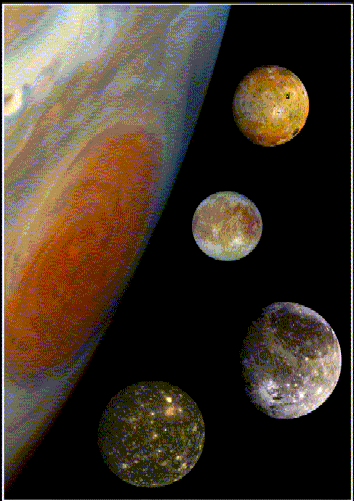
Selected moons of Jupiter, drawn to scale. Starting from top: Io, Europa, Ganymede, and Callisto (courtesy: NASA) |
| WEEK
13 (April 11, 2002)
Read: pp. 218-20 (Asimov); 231-40 (Gray and Moore) Assignment: Summarize ONE of the reading above in one fat paragraph (about half a page, double-spaced) Topics: extraterrestrials and space colonization Film: |

An Extraterrestrial? |

Radio Telescope |
Class Activity: Divide into groups and try to solve the following problem (courtesy of NPR's Click and Clack). You have 1000 single dollar bills and 10 envelopes. Place the money in the envelopes, then seal and label the envelopes. Place the singles in such a way that, if anyone asks you for any sum of money between $1 and $1000, you can give that sum by handing them between 1 and 10 envelopes.
After groups solve the problem, we will: 1. Explore the solution, 2. extrapolate it (that is, answer such questions as: How many envelopes are needed to produce any number up to one million? one billion?), 3. ask: What does this problem tell us about the nature of mathematics? and, 4. Compare this problem to the Dewdney's problem of Week 8.
WEEK 14 (April 18, 2002)
Read: pp. 241-257.
Topics: Overview of Atoms & Stars; The Nature of Science Revisited: What is Science? Odds and Ends; Teaching evaluations
WEEK 15 (April 25, 2002)
Final Exam:
Optional Makeup Tests and Papers